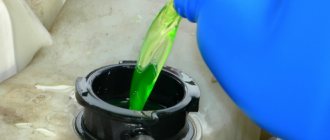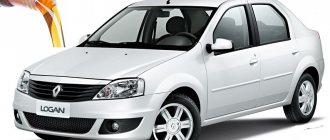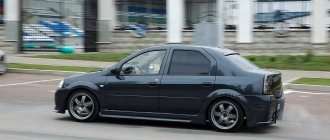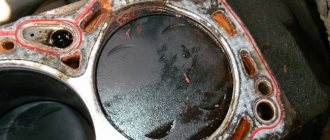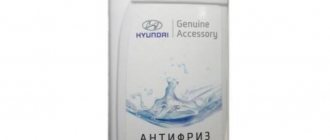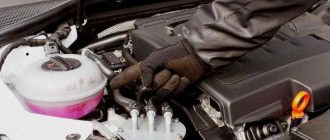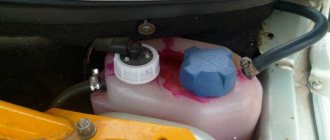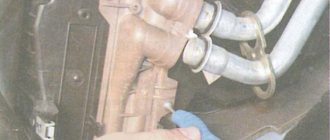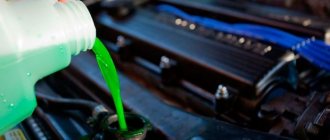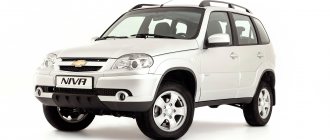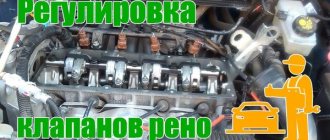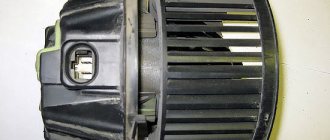How to replace antifreeze on Renault Logan?
Replacing antifreeze on a Renault Logan includes draining the fluid, flushing the system if necessary, and adding new antifreeze. Knowing the precautions and what tools should be prepared will help you replace antifreeze on Renault Logan, in particular, as well as on Renault Sandero and Renault Koleos, without difficulty.
A complete replacement of antifreeze on Renault Logan is possible using the following tools and consumables:
- To protect the skin, gloves and thick rags made from natural fabrics are used;
- Tools: ten key for removing crankcase protection;
- screwdriver;
- hose clamps;
- pliers.
- 6 liters of water, which are mixed with ELF GLACEOL RX Type D Renault 7711428132 antifreeze in a ratio of 1/1;
So, how much coolant is needed to replace antifreeze in Renault Sandero and Logan, and which one should you choose? Until 2009, Renault recommended TOTAL GLACELFAUTOSUPRA. Now, this product is practically not found on sale, so a product such as ELF GLACEOL RX TypeD is relevant.
The liquid described above is a concentrate, which is diluted with distilled water in a ratio of 1/1. Owners of Renault Logan with 1.4 and 1.6 engines purchase 5.5 liters of antifreeze. Three 1-liter canisters are diluted halfway with water. The remaining half liter of the finished liquid is used if necessary to add the product to the tank.
Precautionary measures
Please note that compliance with safety measures when performing such actions is mandatory.
- It is necessary to allow the engine to cool, as well as the fluid in the cooling system. In operating condition, the temperature rises to 90 degrees, which is incompatible with performing the required actions;
- Antifreeze contains chemical elements that can cause harm if it comes into contact with the skin;
- It is important to depressurize the cooling system itself to perform subsequent maneuvers. This is achieved by unscrewing the cap of the expansion tank;
- It seems reasonable to prepare a container in advance where the product will be drained. Since its composition is chemical, it can damage the area of the earth where it spills.
Draining the coolant and flushing the system
How to replace antifreeze in Renault Logan yourself? You should start by draining the unusable liquid. First, excess pressure in the Renault Logan cooling system is released. The expansion tank cap is opened, after which a number of actions are performed:
- The engine protection, which is attached with 6 bolts, is removed. To do this, they need to be unscrewed;
- A container is installed under the engine into which used antifreeze will be drained. In practice, it is convenient to use a cut canister;
- The expansion tank cap should be closed at the initial stage, which will reduce the intensity of the drain;
- Using a slotted screwdriver, disconnect the hose clamp on the lower radiator pipe;
- After removing the sleeve, the coolant is drained into a fixed container;
- To increase the pressure, it is necessary to remove the plug from the expansion tank, then unscrew the fitting, thus releasing air from the system;
- After the coolant has been completely drained, attach the hose to the radiator pipe. It must be secured with a new worm clamp.
A number of motorists ask the question: is it necessary to flush the cooling system when replacing antifreeze in a Renault Logan? To answer this question, it is necessary to establish 2 important points:
- what is the service life of the car?
- How long has the antifreeze been in use, or when was it last changed?
Having received answers to these questions, you can decide whether the system needs to be flushed.
In any case, flushing your car's cooling system is never unnecessary. To do this, insert a water supply hose into the filler neck, after which running water is turned on. By the color of the liquid coming out, you can understand how thoroughly the system requires cleaning.
If the radiator is not operating satisfactorily, it must be flushed. You can do this yourself, or seek the help of a specialist. But what to do in case of complex pollution? To do this, special cleaning agents are used, which are diluted in water and the system is washed. The car must be used for up to 2 days, after which fresh antifreeze is added.
We recommend: Independent replacement of the VAZ 2114/15 heater radiator: how to carry out the procedure in different ways
Filling with new antifreeze
The scheme for filling the cooling system with antifreeze is as follows:
- Coolant is poured through the neck of the expansion tank. This is done until the antifreeze fills the required volume and flows out of the air bleeder hole;
- The expansion tank cap is screwed on, as well as the fitting cap;
- The driver starts the engine and waits for the cooling system fan to turn on. After this, it is necessary to stop the internal combustion engine;
- Allow the engine to cool;
- Release the air using the fitting;
- Check the level of filled antifreeze. If it does not reach the required level, top up;
- Reinstall the engine crankcase protection;
- Having followed the above recommendations, the process of replacing antifreeze in Renault Sandero, like Renault Logan, is completed.
Block in the cabin
It is located at the left end of the dashboard and is closed with a lid.
On its back there are: a diagram of the location of fuses in Renault Logan 1, plastic tweezers and 4 spare fuses with ratings of 5, 10, 15, 30 amperes. There is no relay in the cabin. The explanation of the scheme is given in the table below.
| Fuse designation | Denomination, A | Protected elements |
| F01 | 20 | Windshield wiper; Heated rear window |
| F02 | 5 | Power supply for instrument cluster; Fuel pump and ignition coils; Power supply to the engine ECU from the ignition switch |
| F03 | 20 | Stop lights; Reversing lights; Windshield washer |
| F04 | 10 | Airbag computer; Turn signals; Engine management system diagnostic connector; Immobilizer coils |
| F05-F08 | – | Reserve |
| F09 | 10 | Low beam (left side); Low beam indicator on the instrument panel; Headlight washer pump |
| F10 | 10 | Low beam (right side) |
| F11 | 10 | High beam (left side); High beam indicator on the instrument panel |
| F12 | 10 | High beam (right side) |
| F13 | 30 | Power windows for rear doors |
| F14 | 30 | Power windows for front doors |
| F15 | 10 | ABS ECU |
| F16 | 15 | Driver and passenger seat heating switch |
| F17 | 15 | Sound signal |
| F18 | 10 | Side lights: left side; License plate lighting; Lighting: instrument cluster, controls on the instrument panel, console and floor tunnel lining; Switch box buzzer |
| F19 | 7.5 | Side lights: right side; Glove compartment lighting |
| F20 | 7.5 | Rear fog light lamps and warning light |
| F21 | 5 | Heated exterior mirrors |
| F22 – F23 | – | Reserve |
| F24 | 5 | Electric power steering pump |
| F25 | 5 | PGBN injection system |
| F26 | 5 | Airbag and seat belt pretensioner control unit |
| F27 | 20 | Rear wiper motor; Windshield wiper-wash switch; Headlight washer pump; Reversing light switch |
| F28 | 15 | Interior and trunk lighting lamps; Constant power supply to the head unit for sound reproduction |
| F29 | 15 | Hazard switch; Turn signal switch; Intermittent operation of the windshield wiper; Central locking; ECM diagnostic connector |
| F30 | 20 | Central locking power circuit |
| F31 | 15 | Fog lights |
| F32 | 30 | Heated rear window |
| F36 | 30 | Heater fan |
| F37 | 5 | Electric exterior mirrors |
| F38 | 10 | Cigarette lighter; Power supply to the head unit for sound reproduction from the ignition switch |
| F39 | 30 | Heater fan |
Removing old fluid
Do not attempt to pull off the lower radiator hose without first loosening the tension clamp. When removing the locknut, you need to inspect the clamp. If it is original, it will have to be replaced. The French automaker supplies disposable clamps.
Next you need to proceed in the following order:
- The hoses are removed from the radiator and the expansion tank pipe. This will allow you to quickly drain the Renault Logan antifreeze and ensure a high-quality replacement in the future.
- Due to the design of the car, simply disconnecting the hoses will not completely get rid of antifreeze. Some of it will remain in the radiator. To completely remove antifreeze, you need to remove the tubes from the thermostat hoses and lower their container with the drained liquid.
- The cooling system is purged using a compressor. Air must be supplied simultaneously - through the expansion tank and thermostat hoses. The pressure should not be excessive to prevent damage to the radiator honeycomb.
- After the cooling system is completely empty, you can return all hoses and clamps to their place.
After the procedures have been completed, you can begin to fill in new fluid. The choice of antifreeze is up to the car owner. There was a time when Renault engineers recommended using antifreeze called GLACELF AUTO SUPRA produced by Total. It is easily recognized by its orange color. But today the automaker recommends using Renault Glaceol RX Type D. Antifreeze of this brand is available in the form of a concentrate, and before filling it must be diluted with distilled water.
Products from both brands can be safely used. It is of high quality and is suitable for the Renault Logan cooling system with 1.4 and 1.6 engines.
The order of steps for changing the coolant. mixtures
- Crawl under your car, then you should unscrew the so-called engine protection and remove the inner shield. This shield protects the left side of the engine from dirt getting into it. After this, place a canister under the drain to collect the mixture.
- Completely unscrew the drain plug of the engine cooling mechanism. Next, you need to unscrew the top part of the filler tank.
- You can also partially unscrew the plug (if the pressure level drops, unscrew it entirely).
- After draining the mixture from the radiator, screw everything back in as before. Loosen the compression force of the valve on the internal pipe, then drain the remaining mixture from the engine.
- Using a pump or syringe, it is worth pumping out the old antifreeze from the expansion tank and pouring in fresh one.
- Fill with fresh mixture until the mixture flows out. Next, simply close the lid.
Towards the end of replacing the antifreeze, you should definitely turn on the engine of your Logan and let it warm up before starting work (which, in general, will make it possible to make sure that the cooling system is working correctly).
After replacement, check the overall antifreeze level. If there is not enough antifreeze in the tank, bring it to the “F” mark.
- If on a heated engine there is no warm flow from the internal heater, this may indicate the appearance of a water/air plug in the cooling system. If the air is a little warm when the engine is running, then the fan is faulty, but if it is cool, there is a plug in the coolant mixture.
- Loosen the compression force of the valve on the internal radiator pipe, then unscrew it and drain the remaining mixture from the engine.
As can be seen from the text above, replacing antifreeze in a Renault Logan 1.6 8-valve version is essentially a fairly simple procedure. Doing this work on your Logan yourself gives you new knowledge and allows you to save money on repairing your car. This is also an overall great opportunity to get to know your car and see it in a new light.
The above instructions will allow the user to carry out re-solidification of antifreeze on their own without the help of people. Now you know how to do it. As a result, you also get the opportunity to save your money and, in the future, carry out this work more confidently.
Preparing to replace antifreeze: important tips and tricks
For drivers of a car of this brand, it is better to replace the coolant in advance, namely when it becomes characteristically dirty-brown. In this case, the liquid will become unpleasant and smell sharp, and such changes will occur after 60 thousand kilometers.
To prepare for a simple operation to replace antifreeze, you will need several necessary items, including tools and consumables.
- It is important to prepare several types of wrenches, among which there should be open-end and cap options.
- You should have pliers and a screwdriver on hand.
- To drain the waste liquid, you need to prepare a wide container with low sides, which would correspond to a volume of 6 liters.
- Many drivers use the neck of a plastic bottle as a funnel.
- It is necessary to stock up on rags and cloth or rubber gloves.
Undoubtedly, for convenience, you can use an inspection hole, since in the absence of one you will have to climb under the car and perform all the necessary manipulations while lying on the floor or ground. Before starting work, the engine must be completely cooled, and the valve located at the neck of the expansion tank must be unscrewed to reduce excess pressure in the cooling system. After the cover is removed, you will hear a characteristic sound, after which the cover should return to its place.
Unfortunately, Renault does not have any precautionary plugs or other devices for the release of used antifreeze, so it is drained after removing the system pipes. To begin, remove the lower hose from the radiator, unscrew and remove the tray protecting the crater, then place a container prepared in advance under the radiator. It is more convenient to carry out this work in an inspection hole, then you can throw a board over the hole and install a container on it to collect the waste product.
Instructions for filling the system
Using a funnel, new antifreeze is poured into the Logan system through the neck of the expansion tank - the drain plug must be unscrewed. You should pour slowly, taking pauses, during which you should press all the pipes with your hands to remove air pockets. The process continues until a trickle flows from the fitting. At this moment, you need to quickly remove the funnel from the neck and close it with your right hand, stopping the liquid from flowing out. With your left hand, tighten the fitting plug and add the required amount into the expansion tank. The level should be located between the minimum and maximum marks.
The next step is to release air from the cooling system:
- After making sure that the clamps are tight and the plugs are tightened, start the engine. Warm it up for a few minutes at idle speed to a temperature no higher than 400 and turn off the engine.
- Before bleeding air after replacing the fluid, it is necessary to eliminate excess pressure in the system by unscrewing the expansion tank plug. Attention! The system operates under pressure: always operate with caution, especially when the engine is hot. If you unscrew the lid quickly, hot air will splash out and burn your hands.
- Covering the expansion tank with your right hand, unscrew the fitting with your left hand and remove your hand from the neck of the tank. As soon as the air comes out and liquid runs out of the fitting, close the filler hole again and screw the drain valve plug into place. Screw and tighten the reservoir cap securely.
- Since the Logan stove radiator is located slightly higher than the rest of the cooling system, air will still remain in it. To get rid of it, a new one should be pumped in under pressure created by a water pump. You need to start the engine again and warm it up for 5–10 minutes at high speeds (up to 2000 rpm), monitoring the temperature sensor to avoid overheating of the power unit.
- Repeat bleeding the air from the fitting, only now do not cover the neck of the tank with your hand, but twist and unscrew its cap to avoid burns to your hands. The procedure will have to be repeated 2-3 times, only then you can drive.
After replacement, there may be residual air in the system for a long time. This may be indicated by temperature fluctuations or insufficient heating in the car interior. Therefore, while driving, air can be periodically removed, as described in the video:
If there is a need to flush the Renault Logan cooling system, then you can follow the instructions described; only after filling in the flushing fluid does it make sense to carefully remove the air plugs. It is enough to let the engine run for a while without allowing it to overheat.
Add a comment
Click to cancel reply.
Scope of application
Ready-to-use Renault coolant
The original antifreeze from Renault was developed for use in the cooling systems of any modern internal combustion engines. It is best suited for Renault-Nissan engines.
It is completely neutral to metal alloys and rubber compounds, which allows it to be used in cooling systems with copper and rubber parts.
Important! In the event of an antifreeze leak, the manufacturer strongly does not recommend mixing it with other brands of antifreeze, even if they have a similar green color. The best solution would be to add the same antifreeze to the cooling system. If you don’t have the same canister of Antifreeze concentrate Renault Type D with you, you can mix it with ordinary distilled water until the leak is eliminated and all the coolant is replaced.
Regulations for Renault Logan
According to the regulations from the official dealer, antifreeze under the ELF GLACEOL RX Type D Renault brand is recommended for replacement as a coolant.
Factory antifreeze catalog number
The chemical composition of such a product includes distilled water, ethylene glycol (96% of the total composition) and 4% of various additives, which provide all components with anti-corrosion resistance from external factors. Such corrosion inhibitors are suitable for use in all cooling systems for both copper and aluminum radiators.
The recommended antifreeze is completely safe for plastics, paint, varnish, as well as rubber pipes and seals.
What does branded antifreeze look like?
Renault Glaceol RX Type D concentrate
Branded antifreeze for Renault Logan is yellow in color and is supplied as a concentrate in 1 liter bottles.
It should be diluted in a clean container in a 1:1 ratio with distilled water. A diluted composition in this ratio performs well at temperatures as low as -40°C.
However, if the ambient temperature does not drop to such levels, the percentage of concentrate in the water can be adjusted independently in other proportions.
Under the hood of the two-liter Renault Logan in the new body there is also yellow antifreeze (photo of the editorial car)
Manual
According to the operating manual for the Renault Logan car, the antifreeze should be completely replaced every 90,000 kilometers.
However, you shouldn’t specifically wait for this mileage; you need to monitor the color of the coolant, and when it acquires a dirty shade with an unpleasant odor, it means it’s time to make a replacement, thereby pouring the product only into a clean environment, having previously cleaned the system of old fluid.
Such recommendations are given to ensure that the composition of the used product does not interfere with the effective operation of the newly filled antifreeze. To completely replace the system, you will need from 6 to 8 liters (depending on engine size) of antifreeze diluted to the required concentration.
Selecting replacement antifreeze also requires experience
For the first Logans, TOTAL antifreeze (GLACELFAUTOSUPRA TM) was used; for the second generation, when delivered to the market, GLACEOLRX Type D from the ELF brand is filled. It is initially diluted with distillate. The manufacturer recommends both of these types for filling into Logan 2 with 1.4 or 1.6 liter engines. The volume for refilling the system corresponds to 5.5 liters.
A little more about type “D”. It complies with G-12 standard:
- Cool Stream 4030 Premium;
- Glacelot RX (Type D).
They can be either ready-made or in the form of concentrates.
Also, for Renault Logan 2, according to the manufacturer’s recommendations, our car service uses antifreeze (depending on the year of manufacture) from: MOTUL, Freecor QR, Freecor DSC, VAG, Castrol Radicool Si, FEBI, Zerex G, Glysantin (all type G12++).
If a concentrate is used, it is diluted in advance with distilled water. Our car service offers liquids that remain effective after dilution 50x50 to 40 degrees below zero. If the average ambient temperature in winter is different, the master can change the proportions.
Causes of leaks
Antifreeze leaks are a fairly common problem that requires immediate attention. Even minor leaks can turn into serious leaks at the worst possible time. As a result, the engine overheats, which leads to problems with the motor. It is important not only to find the place where the leak occurred, but also to completely eliminate the cause.
The engine cooling system consists of a number of elements, as well as connecting pipes. Antifreeze, which is a mixture of water and coolant, heats up as the internal combustion engine heats up. As a result, the causes of leaks can be:
- defects in connections responsible for tightness and tightness;
- problems with the elements of the cooling system;
- wear of elements;
- mechanical damage to the elements of the car cooling system;
- errors when assembling elements after repair work;
- violation of the rules for using a car;
The primary sign that there is a problem in the system is the level of antifreeze in the expansion tank. Its constant decrease indicates leaks.
A characteristic sign of a leak is wet spots and collected drops. If this cannot be detected by visually inspecting the parts, then all components of the cooling system should be checked.
More serious problems with antifreeze leakage include cracks in the block and cylinder head. Such a defect can lead to antifreeze entering the internal combustion engine cylinders, leading to mixing of coolant with engine oil. As a result, the antifreeze level drops and the lubricant loses its properties. It is necessary to immediately eliminate the problem, as the unit wears out and may jam and fail.
In conclusion, it is worth noting that in order to avoid breakdowns, leaks and the need to completely replace antifreeze on Renault Logan, you should not add water to the antifreeze when the fluid level decreases in the cold season. The percentage ratio of the required concentration is violated, which leads to freezing of the coolant in the system. The risk of damage to the cooling system and engine failure increases.
Preparing for work
Coolant is necessary to remove excess heat from a running engine. The productivity of the Renault Logan engine depends on its quality. Particular attention should be paid to replacing antifreeze.
ATTENTION! A completely simple way to reduce fuel consumption has been found! Don't believe me? An auto mechanic with 15 years of experience also didn’t believe it until he tried it. And now he saves 35,000 rubles a year on gasoline! Read more"
Today you can buy any coolant in stores, but for a safe replacement you need to choose the one recommended by the manufacturer. You can find out what antifreeze to buy and how much to fill in from the user manual. Every car manufacturer applies it to their products.
Despite the fact that the French automaker recommends replacing antifreeze after 90,000 km, experienced car enthusiasts insist on a complete replacement of the coolant after a mileage of 60,000 km. The fact is that by this time its color and main characteristics change, it begins to smell unpleasant.
To perform routine maintenance, you will need the following tools and consumables:
- Open-end and box-end wrenches.
- Pliers and screwdriver.
- Low container for collecting antifreeze (at least 6 liters).
- Plastic funnel. If necessary, it can be replaced with the cut off neck of a plastic bottle.
- Fabric gloves.
- Rags.
Before starting work, the car must be driven into the pit. This will make it easier to access the oil pan. In addition, you will have to remove the engine protection: it will interfere with replacing the antifreeze.
An important preparation step is removing excess air from the expansion tank. This should be done exclusively on a cold engine. You should remove the cap from the neck of the tank and wait for the air to escape , after which the cap can be returned to its place.
Logan does not have a specialized coolant drain. Therefore, in order to change antifreeze on Renault Logan, you will first need to place a container under the radiator.
Low prices and quality guarantee
There are some nuances that affect the effectiveness of the procedure. For example, a specialist never starts replacing antifreeze the minute the car is delivered to the service center. The engine must be completely cool during operation.
Also, before replacement, excess pressure is removed from the system. A drain container is installed under the removed pan. And without following safety precautions, you can easily get injured.
And besides, when doing independent repairs, the search for the necessary materials is inevitable, the question arises about the advisability of using one or another antifreeze for a certain car model, a loss of money and time.
All this can be avoided by contacting a car service center.
- professionals work;
- non-freezing liquid is selected without errors from the catalog;
- the procedure itself takes a little time;
- the next antifreeze replacement will be required for a very, very long time;
- Additionally, at your request, diagnostics and repair of other components and mechanisms can be carried out;
- All work is guaranteed.
Hi all! Today we’ll talk about how to replace antifreeze in Renault Logan. Let's say right away that replacing the coolant is recommended for Renault Logan and Sandero after 3 years from the previous replacement or after 90 thousand kilometers on the odometer. In some articles there is information that the coolant needs to be changed after 6 years, but we understand that in our difficult operating conditions (sometimes hot and sometimes cold) and assembly in dusty workshops, it would be good to replace it as early as possible.
How to properly pour antifreeze into the system
Through the expansion tank and its neck through a funnel, the new product enters the cooling system. Do not rush during the process, gradually push the pipes by hand so that the air plugs come out of them. This process must continue until the liquid flows out of the fitting. After this, the funnel is removed from the neck using the right hand, and the left hand at this time should have time to tighten the screw. The required level of antifreeze is added through the expansion tank.
Make sure that all plugs are screwed in tightly and try to start the engine. It is necessary to warm it up idle and then stop it again.
If this process is too complicated for you, you should contact any car service center.
Tools and consumables
What tools and consumables are required to replace fluid in the cooling system?
It should be remembered that while working in the cooling system, the engine must also be cold. In addition, before the procedure, you need to open the hood and turn the cap of the expansion tank (indicated by number 2 in the figure). There will be a hissing sound. This way you can remove excess pressure. The main thing is not to suddenly open the lid when the engine is warm. Otherwise, one or two liters of liquid will escape from the tank and burn your hands (geyser effect). You must wear gloves when opening the lid, as antifreeze is poisonous.
Reviews
Nikolai, 30 years old Good antifreeze, does not freeze even in the most severe cold. It has to be changed every two to three years. Overall I recommend it.
Maxim, 24 years old I have no complaints about this refrigerant, the only negative is the inflated price.
Yuri, 40 years old I always use this original antifreeze as I try to take care of my car and use only original products.
Evgeniy, 53 years old Having studied reviews on the Internet, I still could not understand how this coolant differs from analogues except for the price. Antifreeze may be good, but its cost is not justified.
